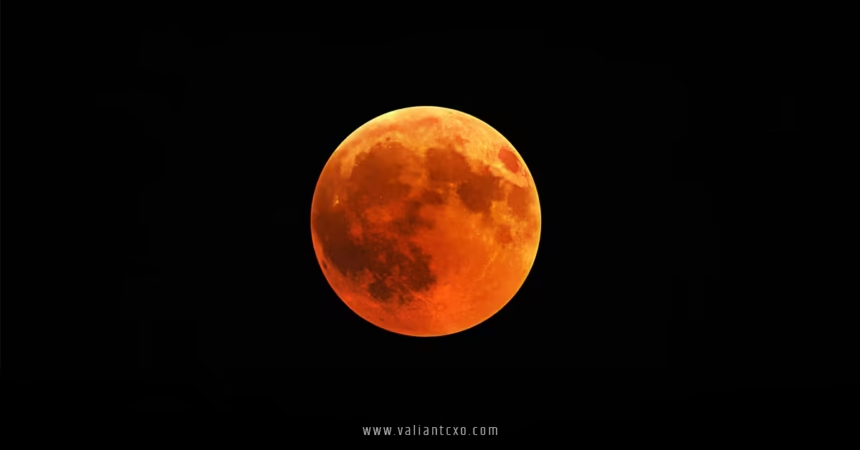total lunar eclipse blood moon is one of nature’s most jaw-dropping performances, transforming the familiar silver glow of the moon into a striking crimson masterpiece. Imagine the night sky as a grand theater, with the moon stealing the spotlight in a rare, dramatic act. But what exactly makes this celestial event so mesmerizing? Let’s dive into the science, beauty, and cultural significance of a total lunar eclipse blood moon, unraveling why it captivates skywatchers worldwide.
What Is a Total Lunar Eclipse Blood Moon?
A total lunar eclipse blood moon occurs when the Earth passes directly between the sun and the moon, casting a shadow that fully engulfs the lunar surface. Unlike a solar eclipse, where the moon blocks the sun, this event sees the moon slip into Earth’s shadow, known as the umbra. The “blood moon” nickname comes from the moon’s eerie red hue during totality, a result of sunlight filtering through Earth’s atmosphere. Think of it like a cosmic sunset projected onto the moon—pretty cool, right?
The Science Behind the Red Glow
Why does the moon turn red during a total lunar eclipse blood moon? It’s all about Earth’s atmosphere acting like a giant lens. As sunlight passes through our planet’s atmosphere, shorter blue and green wavelengths scatter, leaving longer red wavelengths to reach the moon. This process, called Rayleigh scattering, is the same reason sunsets glow red. The intensity of the red color can vary, depending on atmospheric conditions like volcanic ash or pollution. A dusty atmosphere might make the blood moon appear darker, almost like a burnt ruby, while a clear one creates a vibrant scarlet.
Types of Lunar Eclipses
Not all lunar eclipses are created equal. To understand a total lunar eclipse blood moon, it’s helpful to know the three main types:
- Penumbral Eclipse: The moon passes through Earth’s faint outer shadow (penumbra), causing a subtle dimming. It’s like the moon is wearing a light veil—hardly noticeable.
- Partial Eclipse: Only part of the moon enters the umbra, creating a dramatic “bite” taken out of its surface. It’s a teaser for the main event.
- Total Eclipse: The moon is fully immersed in the umbra, resulting in the iconic total lunar eclipse blood moon. This is the showstopper, where the moon transforms entirely.
When and Where Can You See a Total Lunar Eclipse Blood Moon?
Unlike solar eclipses, which require you to be in a specific path, a total lunar eclipse blood moon is visible from anywhere on Earth’s night side, as long as the sky is clear. The event can last several hours, with totality—the peak red phase—often spanning about an hour. So, when’s the next one? Websites like NASA’s Eclipse Predictions provide detailed schedules for upcoming eclipses. Typically, one or two total lunar eclipses occur each year, but not all earn the “blood moon” title due to varying atmospheric conditions.
Best Viewing Conditions
To catch a total lunar eclipse blood moon in all its glory, you’ll want a clear view of the sky. Here’s how to maximize your experience:
- Find a Dark Spot: Light pollution from cities can dull the moon’s red glow. Head to a rural area or a high vantage point, like a hilltop, for the best view.
- Check the Weather: Clouds are the ultimate buzzkill for eclipse viewing. Keep an eye on local forecasts.
- Use Binoculars or a Telescope: While a total lunar eclipse blood moon is visible to the naked eye, optical aids can reveal stunning details, like craters glowing faintly in the red light.
Why Is a Total Lunar Eclipse Blood Moon So Special?
There’s something magical about a total lunar eclipse blood moon that transcends science. It’s a rare moment when the cosmos feels alive, inviting us to pause and marvel. Unlike fleeting meteor showers, a blood moon lingers, giving you time to soak in its beauty. It’s like the universe is saying, “Hey, stop scrolling and look up!”
Cultural and Historical Significance
Throughout history, a total lunar eclipse blood moon has sparked awe and fear. Ancient civilizations often saw it as an omen. The Incas believed a jaguar was attacking the moon, while some Native American tribes thought it signaled a time of renewal. In modern times, the blood moon has taken on spiritual significance for some, symbolizing transformation or heightened energy. Even if you’re not into mysticism, it’s hard to deny the emotional pull of watching the moon turn crimson.
The Blood Moon in Pop Culture
The term “blood moon” has also seeped into pop culture, thanks to its dramatic flair. Books, movies, and even video games use the total lunar eclipse blood moon as a backdrop for epic moments. Remember that scene in your favorite fantasy series where the sky turns red, and something epic happens? That’s the blood moon’s influence at work, stirring our imaginations.
How to Photograph a Total Lunar Eclipse Blood Moon
Want to capture the total lunar eclipse blood moon for your Instagram feed? Photographing it can be tricky but rewarding. Here’s a beginner-friendly guide to get that perfect shot:
Equipment You’ll Need
- Camera with Manual Settings: A DSLR or mirrorless camera works best, but a smartphone with a good night mode can do the trick.
- Tripod: The moon moves faster than you think, and a steady tripod prevents blurry shots.
- Telephoto Lens: A lens with at least 200mm focal length brings out the moon’s details. No lens? A telescope with a camera adapter works too.
Camera Settings for Success
- ISO: Start with ISO 100–400 to keep noise low.
- Aperture: Use a wide aperture (f/2.8–f/5.6) to let in more light.
- Shutter Speed: Try 1/100s for the partial phases and 1–3 seconds during totality, when the moon is dimmer.
- Focus: Set to manual focus and adjust until the moon’s craters are sharp.
For more photography tips, check out EarthSky’s Guide to Lunar Eclipse Photography.
Common Myths About the Total Lunar Eclipse Blood Moon
The total lunar eclipse blood moon has inspired plenty of myths. Let’s debunk a few:
- Myth: It’s Dangerous to Look at a Blood Moon: Unlike a solar eclipse, a lunar eclipse is 100% safe to view with the naked eye. No special glasses needed!
- Myth: It Causes Natural Disasters: There’s no scientific link between a total lunar eclipse blood moon and earthquakes or storms. It’s just a beautiful coincidence if they align.
- Myth: The Blood Moon Affects Human Behavior: While some claim it influences emotions, there’s no evidence to support this. Still, it’s a great excuse to feel a little wild under the red glow!
Tips for Hosting a Total Lunar Eclipse Blood Moon Viewing Party
Why enjoy a total lunar eclipse blood moon alone? Turn it into a memorable event with friends or family. Here’s how to host a stellar viewing party:
Set the Scene
- Pick a Great Spot: Choose a location with a clear view of the sky, like a backyard or park.
- Bring Comfort: Blankets, lawn chairs, and hot drinks make the night cozy, especially if it’s chilly.
- Add Ambiance: Play a space-themed playlist or share fun facts about the total lunar eclipse blood moon to keep guests engaged.
Engage Your Guests
- Share the Science: Explain why the moon turns red using the sunset analogy. It’s a crowd-pleaser!
- Involve Kids: Give them glow sticks or let them draw the moon’s phases to spark their curiosity.
- Capture the Moment: Set up a photo booth with a moon-themed backdrop for fun selfies.
For inspiration on hosting skywatching events, visit Sky & Telescope’s Viewing Guide.
The Future of Total Lunar Eclipse Blood Moons
The total lunar eclipse blood moon isn’t going anywhere—Earth, the moon, and the sun will keep aligning for millennia. But each eclipse feels unique, shaped by the atmosphere and our personal experiences. NASA predicts several blood moons in the coming years, with some visible from specific regions. Mark your calendar and check trusted sources to plan your next viewing. Who knows? The next total lunar eclipse blood moon might be the one that leaves you starry-eyed.
Why Keep Watching?
Every total lunar eclipse blood moon is a reminder of our place in the universe. It’s a chance to connect with nature, share stories, and marvel at something bigger than ourselves. Whether you’re a science nerd or just love a good show, the blood moon delivers.
Conclusion
A total lunar eclipse blood moon is more than just an astronomical event—it’s a moment that bridges science, culture, and wonder. From its striking red glow to its historical significance, this celestial spectacle invites us to look up and dream. Whether you’re snapping photos, hosting a viewing party, or simply gazing in awe, the blood moon is a reminder of how beautiful our universe can be. So, grab a blanket, find a dark spot, and let the next total lunar eclipse blood moon steal your breath away.
FAQs About the Total Lunar Eclipse Blood Moon
1. What causes the red color in a total lunar eclipse blood moon?
The red color in a total lunar eclipse blood moon comes from sunlight filtering through Earth’s atmosphere, scattering shorter wavelengths and letting red light reach the moon.
2. Is it safe to look at a total lunar eclipse blood moon?
Absolutely! A total lunar eclipse blood moon is safe to view with the naked eye, unlike a solar eclipse, which requires protective glasses.
3. How often does a total lunar eclipse blood moon occur?
A total lunar eclipse blood moon typically happens once or twice a year, though the exact “blood” effect depends on atmospheric conditions.
4. Can I photograph a total lunar eclipse blood moon with my phone?
Yes! While a DSLR is ideal, a smartphone with night mode can capture a decent shot of a total lunar eclipse blood moon if you use a tripod and adjust settings.
5. Where can I find the schedule for the next total lunar eclipse blood moon?
Check NASA’s eclipse website or other astronomy resources for dates and visibility details for the next total lunar eclipse blood moon.
Read More:valiantcxo.com


